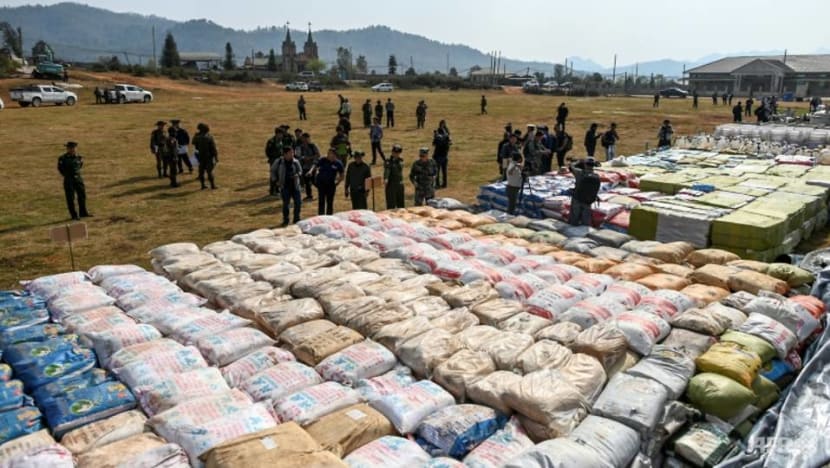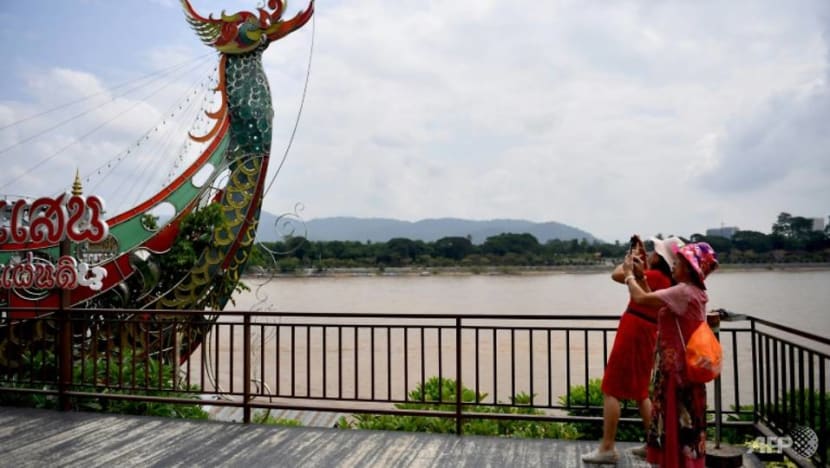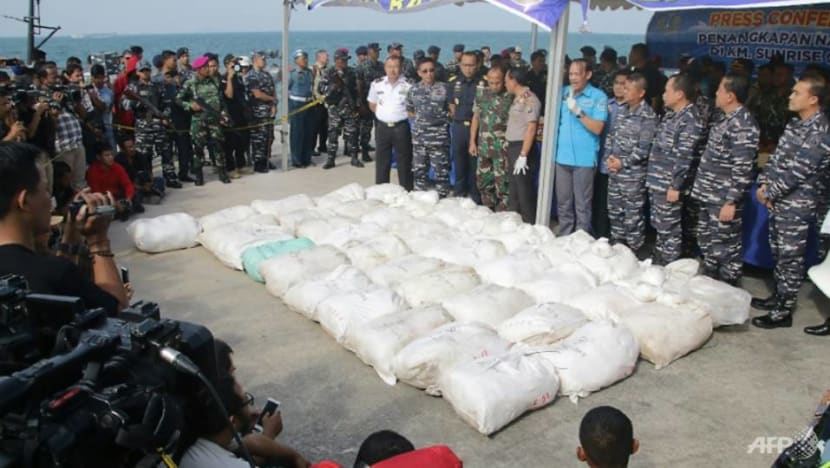commentary Commentary
Commentary: Southeast Asia is now dominant in the illegal drugs trade
Even COVID-19 could not stem the production and flow of illicit drugs from and through the region, say Dr Nehginpao Kipgen and Shivangi Dikshit.

Drug trafficking out of Southeast Asia's 'Golden Triangle' has overwhelmed regional policing efforts and seeded a crisis of addiction, corruption and money laundering. (Photo: AFP/YE AUNG THU)
NEW DELHI: The Golden Triangle Region of Southeast Asia is one of the major producers of illicit drugs.
This region includes northern Thailand, western Laos, and eastern Myanmar. Earlier, the region was known for its opium cultivation, processing and distribution across Southeast Asia and other parts of the world.
However, in recent times the region has occupied a dominant position in the production and trafficking of methamphetamine as media reports estimate the synthetic drug’s total trade value in the Mekong sub-region at over US$40 billion a year.
Another addictive stimulant drug, amphetamine, is also estimated to have a similar trade volume throughout Southeast Asia - between US$30 billion to US$60 billion - according to the United Nations Office on Drugs and Crime (UNODC).
THE GOLDEN TRIANGLE OF SYNTHETIC DRUGS
This rise in the production of synthetic drugs is also due to the availability of precursor chemicals in neighbouring countries like India and China.
These drugs can be easily manufactured in a laboratory with precursor chemicals, like pseudoephedrine and sulphuric acid, and unlike opium, do not need to depend on seasonal harvest.
Myanmar has turned into a major drug producer, whereas Laos and Thailand have turned into major drug trade routes. Drugs are smuggled into the Yunnan Province of China and from there to Guangdong, Hong Kong and Macao.
Similarly, Ho Chi Minh City, Manila and Phnom Penh have become leading centres in the drug distribution.
The drug traffickers use various corridors and shipments from Laos to Thailand, Vietnam and Cambodia, or southern Myanmar to southern Thailand to other parts of the region and beyond.
READ: Commentary: What's behind China's controversial Health Silk Road efforts
Infrastructural development plans such as the Chinese Belt and Road Initiative have created easy passages for such syndicates to traffic drugs to different parts of the world.

The drug syndicates operating in the region have connections with other transnational criminal organisations such as the Japanese yakuza, Vietnamese gangs, Nigerian groups, and Colombian cartels to distribute illicit drugs worldwide.
Transnational criminal organisations are attracted to the drug trade due to its high profit earning capacity.
Drugs, similar to other food items, once consumed need to be purchased again for future consumption. Therefore, the demand for them remains constant, which is not necessarily the case with other illicit items such as arms or precious stones.
The high demand and high profit earning capacity makes it a lucrative trade for transnational criminal organisations.
According to media reports, some ethnic armed groups in Myanmar, such as the United Wa State Army (UWSA), or the National Democratic Alliance Army (NDAA), have been active in the drug trade for decades.
Drugs are mainly produced in the highlands of eastern Myanmar which is poorly developed economically. The armed groups have control over the border region with China, Laos and Thailand.
On the other hand, Thailand and Laos have minimal control over their remote and border areas which make them easily penetrable.
COVID-19 HASN’T CURBED DEMAND AND SUPPLY
The availability of drugs during the COVID-19 pandemic demonstrates the failure of authorities in controlling the expansion of the illicit trade.
READ: Commentary: Still reeling from Duterte’s war on drugs, Manila’s poor hit hardest by COVID-19
“While the world has shifted its attention to the COVID-19 pandemic, all indications are that production and trafficking of synthetic drugs and chemicals continue at record levels in the region,” UNODC representative Jeremy Douglas told media in May.

With changes in the social system since the virus outbreak like social distancing and lockdowns, the drug syndicates have started utilising social media platforms to continue the sale of drugs.
This not only expands the trade but also reduces the cost of drugs as the syndicates drop the parcels at specified locations, and the buyers can easily take their packages from the assigned places.
It has become harder for the police to clampdown these deals as private chats are used to sell and buy drugs.
The current situation where many are facing unemployment or a reduction in income, there is a high vulnerability for the marginalised and economically lower strata of society to participate in the drug business.
READ: Commentary: COVID-19 will leave more young Indonesians unemployed
READ: Commentary: COVID-19 will worsen inequalities across Asia
ADDRESSING THE ROOTS OF THE PROBLEM
To curb the illicit drug trade during and after the pandemic, Southeast Asian countries need to focus, among others, on the social aspects related to drug trafficking in the region.
There is a need to tackle the issue as a societal concern along with it being a non-traditional security threat to the region and the wider world.
There is high demand for drugs like methamphetamine among the youths in Southeast Asia for recreational purposes or as a source of energy to fulfil their daily mundane duties.
Drug consumption is also considered fashionable and a modern thing to do, and is also practiced by the youths to be a part of their social knits.
Both men and women are involved in the distribution and consumption of drugs.
As per the social norms of the region, women are not suspected to be a part of the drug trade, therefore, they are often used to traffic drugs because the drug dealers believe that women will not be or are unlikely to be arrested by the police.
READ: Commentary: COVID-19 is likely to worsen gender inequality in Asia
The conditions at rehabilitation centres can often be challenging, which discourages addicts from completing their treatment.
In his 2015 paper for the Brookings Institution, James Windle wrote that in Thailand, for instance, “compulsory treatment centres are often run by the military” where “human rights groups have reported cruel, inhuman and degrading punishments.”
Moreover, availing these facilities can be expensive in the long-run which discourages drug-users from completing their treatments. Women often leave the rehabilitation mid-way or do not avail such facilities due to the fear of social stigma.

Governments have failed to focus on alternative development programs which can provide drug cultivators alternative means of livelihood.
To reduce the drug trade, it is vital to engage and involve the communities harmed or affected by the illicit trade.
This would help in reducing the social stigma and discrimination towards the drug-users and those who are involved in the drug business.
Moreover, authorities responsible for the implementation of counter-narcotics policies and medical services providers need to be well-trained about the sensitivity of the issue they are dealing with.
The COVID-19 pandemic has caused travel restrictions; and closed borders have affected the production and supply of the drugs.
But a reduced government focus on drug trafficking can allow the drug syndicates to expand their trade in new-found ways.
BOOKMARK THIS: Our comprehensive coverage of the coronavirus outbreak and its developments
Download our app or subscribe to our Telegram channel for the latest updates on the coronavirus outbreak: https://cna.asia/telegram
Dr Nehginpao Kipgen is a Political Scientist, Associate Professor, Assistant Dean and Executive Director at the Center for Southeast Asian Studies (CSEAS), Jindal School of International Affairs, O.P. Jindal Global University. Shivangi Dikshit is a Research Assistant at CSEAS.















